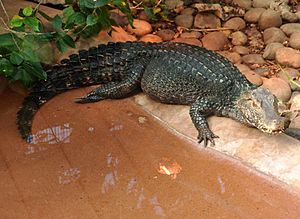Cuvier's dwarf caiman facts for kids
The Cuvier's dwarf caiman is a small crocodilian that lives in South America. It's also known as the musky caiman or simply dwarf caiman. These amazing creatures are the smallest crocodilians found in South America. They were first described by a French zoologist named Georges Cuvier in 1807.
Contents
About the Cuvier's Dwarf Caiman
Cuvier's dwarf caimans are part of a group of reptiles called caimans. They are one of only two species in their special group, called Paleosuchus. These caimans are known for their tough body armor. This armor helps protect them from animals that might try to hunt them.
Where Do They Live?
Cuvier's dwarf caimans live in the northern and central parts of South America. You can find them in countries like Brazil, Bolivia, Colombia, Ecuador, French Guiana, Guyana, Paraguay, Peru, Suriname, and Venezuela. They prefer to live in freshwater places like lakes and rivers. They are often found in the Amazon and Pantanal regions.
How Big Are They?
These caimans are quite small compared to other crocodilians.
- Male Cuvier's dwarf caimans usually grow to about 1.4 meters (4.6 feet) long.
- Female caimans are a bit smaller, reaching about 1.2 meters (3.9 feet) long.
- An adult caiman typically weighs between 6 and 7 kilograms (13 to 15 pounds).
What Do They Eat?
The diet of a Cuvier's dwarf caiman changes as they grow.
- Young dwarf caimans mostly eat small creatures without backbones, like insects. They also enjoy small fish and frogs.
- Adult caimans have a wider diet. They eat larger fish, amphibians (like bigger frogs), and bigger invertebrates such as large molluscs (like snails or clams).
How Long Do They Live?
Cuvier's dwarf caimans can live for a long time. In the wild, they can live up to 40 years. This long lifespan helps them contribute to their ecosystem for many years.
Conservation Status
The Cuvier's dwarf caiman is currently listed as "Least Concern" by conservation groups. This means that their populations are stable, and they are not currently at high risk of disappearing.
Images for kids
See also
 In Spanish: Caimán de Cuvier para niños
In Spanish: Caimán de Cuvier para niños




